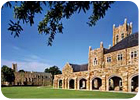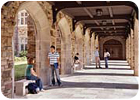

The new library was a significant component of Rhodes 2000 campus master plan, which celebrated the history and patterning of the Rhodes campus, while positioning the college for future generations of students, according to Jane Wright, president of Hanbury Evans Wright Vlattas + Company of Norfolk, VA, the authors of the campus master plan and the architects of record for the new library. “The overall design goal was to place the building to enrich opportunities for student and faculty interaction,†she explained. “During the master planning process, the selection of this site was reinforced by the opportunity to create a desired second campus entry and a new academic quadrangle. The siting of the library and the continued commitment to the Collegiate Gothic architecture as well as the use of stone are the most strategic physical decisions that the college will make in this century.â€
Following the initial planning, Hanbury Evans collaborated with Shepley Bulfinch Richardson and Abbott of Boston, MA, in the development of the library. “One of the challenges was to build this new library in the formal language consistent with the 'brand,' so to speak,†said Ralph Jackson, FAIA, lead architect for Shepley Bulfinch. “But, the institution recognizes the need to create spaces. It's very driven by technology. It needed to have rooms for small group studies and digital classrooms. It was about bringing all these things together, but still maintaining the character and architectural history of the campus.â€

According to Jackson, the placement of the library became the new “front door†for the campus, which is comprised of 100 acres. “It was built on the back of the historical campus,†explained the architect. “Because of the scale of the facility, we were creating a new sense of arrival. It has to act not only as a learning facility, but also as a new gateway.â€
During the planning stages, it was decided that the new library would sit on an existing parking lot, which was between the historic campus and larger buildings that comprise the community. The building had to be smaller on one side to blend with the buildings built in the 1920s, and much more grand on the side facing facilities such as the gymnasium.
“This building was going to be a mediator,†said Jackson. “It became a transitional element. As it faced the historic campus, it needed to be intimate and finely detailed - more picturesque with towers and a cloister. When looking across the historic campus, you needed to see a building that was in keeping with the scale of the historic area. The idea was to blend seamlessly with the other elements. On the other side, the character of the library is more like a 'church scale.' It gives a sense of a large communal facility, and shows signs that it is a growing institution.â€

Designing a master plan with stone
Wright explained that the campus master plan reinforces the college's commitment to stone. The library is the third new stone building that Hanbury Evans Wright Vlattas + Company had recently complete for the college. “The campus is committed to materials with integrity, and stone is frequently used in public interior spaces as well,†she said. “The stone came from the same quarry in Arkansas as the [existing] stone on campus.â€

In addition to extensive use of rubble stone for exterior and interior walls, stonework includes windows and arches that are framed with limestone, giving the new library a commanding presence on campus, while at the same time blending with its surroundings. “We constructed sample panels adjacent to the existing buildings to ensure that the texture and color [of the stone] were compatible with the existing [architecture],†said Wright. “We didn't run into any difficulties. We love working on stone buildings.â€
Contributing to the detailed architecture of the new library, stone symbols were carved into the limestone and integrated into the architecture. “A bust of the president was worked into the carved limestone,†said the architect. “[Also], there are crosses, a Celtic knot and other symbols that represent the heritage of the campus.â€

Installing the stonework
Among the defining architectural elements of the new library are an apse with a copper dome and interior balcony, two towers - one standing at 120 feet tall and the other stretching 65 feet high - and a cloister. Inside, elaborate stone trim, columns, railings and moldings are incorporated into the design.In total, it took approximately 18 months to complete the masonry, according to Project Manager Justin Grinder of Grinder Taber & Grinder in Memphis, TN, the General Contractor for the project. “At any point there were probably 50 masons on site daily - not necessarily the same ones,†he said. “They were everything from piece workers to stone layers.â€
The stonework, which required a great deal of precision and team unity, was completed by W.A. Fortner Masonry, Inc. of Memphis, TN, which has installed the exterior stonework for the last 10 buildings at Rhodes College over the past 20 years. “We had never done anything like this,†stated Tim Fortner, president of Fortner Masonry. “One core group of men trained the next. This type of work takes a real patient guy.â€
The rubble stone pieces were laid in a random pattern, and attention also had to be paid to color variations. “We had to mix color to match the rest of the campus,†said Grinder, adding that the pieces consisted of fluctuating shades of red and brown. “The masonry superintendent would stand away from the building and direct where pieces went, so that one wall wasn't completely different [from the others].â€
The rubble stone pieces measured 5 inches thick and were approximately 2 x 2 and 2 x 3 feet in size. Additionally, the slate pieces measured about 4 inches tall with widths alternating between 1 and 2 feet.

Each piece of stone was chipped and put into place. The stonemasons had to make sure that each piece fit. “That's what gives Rhodes Library its look,†said the contractor. “It's a very beautiful campus. The whole campus looks like this.â€
One challenging aspect of the job was making sure that the stained glass window frames and the window surrounds carved from limestone were a match. “The windows had to be manufactured to within 1â„8 of an inch,†said Grinder. “The order was based on the limestone drawings.†The contractor explained that the window frames were constructed of pre-finished steel, so they couldn't be changed if the measurements were not correct. In the end, all those involved were relieved that the pieces were a fit. The limestone pieces were secured with stainless steel strap anchors.
Construction on the Paul Barret, Jr. Library began in March 2003 and was completed in June 2005. The building includes seminar rooms for small group studies, the Middle Ground 24-hour café, and a variety of open spaces that provide opportunities for informal social interaction.

Rhodes College
Memphis, TN
Original Campus Architect: Charles Klauder with Henry C. Hobbs
Primary Architect: Hanbury Evans Wright Vlattas + Company, Norfolk, VA
Collaborating Architect: Shepley Bulfinch Richardson and Abbott, Boston, MA
General Contractor: Grinder Taber & Grinder, Memphis, TN
Stonemason: W.A. Fortner Masonry, Inc., Memphis, TN
Stone Suppliers: Schwartz Stone Co., Paris, AK (rubble stone); Christie Cut Stone (limestone); Greenstone Slate, Poultney, VT (slate)
